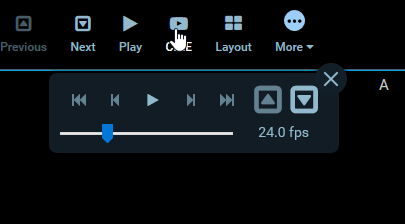Module: Toolbar
An extension can register a Toolbar Module by defining a getToolbarModule
method. This module is commonly used to define:

Example Toolbar Module#
The Toolbar Module should return an array of definitions and a
defaultContext. There are currently a few different variations of definitions,
each one is detailed further down.
export default { id: 'example-toolbar-module',
/** * @param {object} params * @param {ServicesManager} params.servicesManager * @param {CommandsManager} params.commandsManager */ getToolbarModule({ servicesManager, commandsManager }) { return { definitions: [ /* Array of definitions */ ], defaultContext: ['ROUTE:VIEWER'], }; },};Button Definitions#
The simplest definition has the following properties:
{ id: 'StackScroll', label: 'Stack Scroll', icon: 'bars', type: 'setToolActive', commandName: 'setToolActive', commandOptions: { toolName: 'StackScroll' },},| property | description | values |
|---|---|---|
id | Unique string identifier for the definition | * |
label | User/display friendly to show in UI | * |
icon | A string name for an icon supported by the consuming application. | * |
type | Used to determine the button's component and behavior | "setToolActive", "command" |
commandName | (optional) The command to run when the button is used. | Any command registed by a CommandModule |
commandOptions | (optional) Options to pass the target commandName | * |
context | (optional) Overrides module's defaultContext | Array of string context names |
Where a button with a type of setToolActive has an "active" styling applied
when clicked; removing the active styling from all other buttons.
Nested Toolbar Menus#
You can indicate that buttons should be grouped and nested in a submenu by
including buttons property in a definition:
{ id: 'More', label: 'More', icon: 'ellipse-circle', buttons: [ { id: 'cstInvert', label: 'Invert', icon: 'circle', type: 'command', commandName: 'invertViewport', }, ],},
Custom Components#
The Toolbar Modules supports rendering custom components in place of the
application's default. In place of the type, commandName, and
commandOptions properties, we instead specify a CustomComponent.
{ id: 'Custom', label: 'Custom', icon: 'custom-icon', CustomComponent: CustomToolbarComponent,}
The CustomComponent components will receive the following props:
<CustomComponent parentContext="{parentContext}" toolbarClickCallback="{_handleToolbarButtonClick.bind(this)}" button="{button}" key="{button.id}" activeButtons="{activeButtonsIds}" isActive="{isActive}"/>| Property | Type | Description |
|---|---|---|
activeButtons | string[] | list of active buttons |
button | object | its own definition object |
key | string | React key prop |
isActive | boolean | If current button is active |
parentContext | ? | The parent component's context? |
toolbarClickCallback | func | Callback method for clicks |